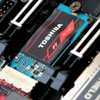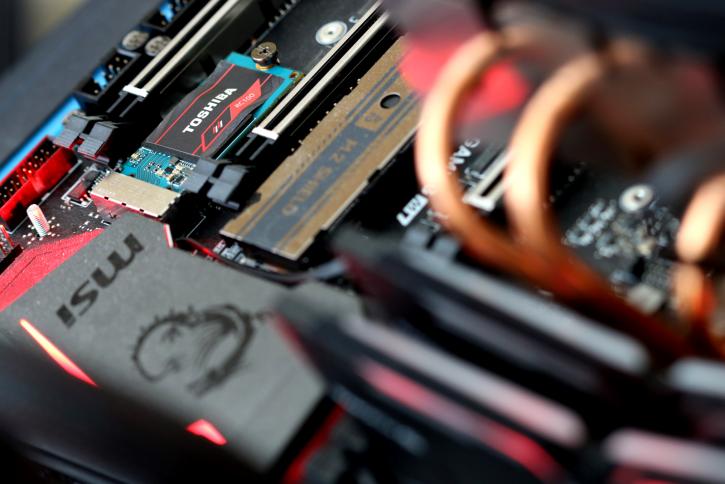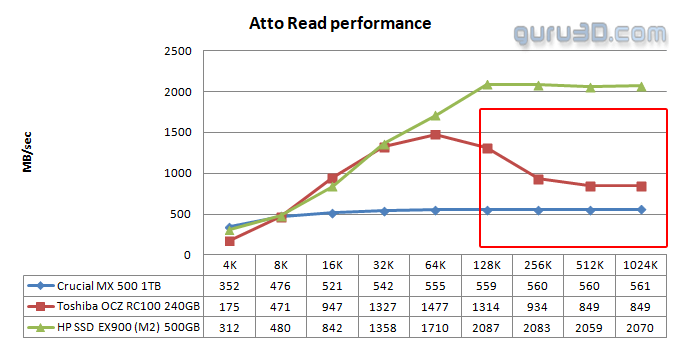Final Words & Conclusion
Final Words & Conclusion
This is our second DRAMless cache design SSD we review this year. An SSD with no DRAM cache normally is batpoop crazy to think about. The thing is though, while it might not have a DRAM cache chip, it still is using DRAM, yet borrows a chunk from your system memory, and it's precisely that fact that makes the distinct difference. So in the end, you're still paying for a DRAM cache in some form. Your system DDR4 memory sells at roughly 12 EUR/USD per GB. HMB works in a 1:1 fashion, so the 480 GB SSD uses 480 MB of your memory as cache, realistically and virtually you need to add a price tag of 6 EUR/USD to this SSD and say 3 bucks for a 240 GB version as tested today. Now I think that is a small price to pay as long as you can spare that up-to 512MB of DDR4 memory overall, ergo this new approach might be extremely cost-effective. Also and I know I mentioned this multiple times already (but I am doing so for a reason) you need to understand that you need to have Windows 10 (latest Fall Creators Update) installed for that Host Memory Buffer technology to be able to work. The concept, however, is interesting and works. What's also batpoop crazy is to see one single chip on a PCB, and that's it. Embedded into that NAND chip is a PCIe-to NAND controller. Toshiba did not hand out any information on that though I hinted already at an IP partner for that on page two of this review. In the end, the SSD stripped from a DRAM cache equals a nice price reduction. The performance, however, did not disappoint whatsoever. Reads wise this unit can keep up with enthusiast class NVMe SSDs, writes are a little ickier here and there, but still twice to triple of that compared to a regular SATA3 SSD. So I am inclined to be positive here The results mean that this fast-performing M.2. unit costs just under 30 cents per GB, and street prices might actually be lower. Not bad huh? Performance wise with some very small exceptions, the SSD was fine for any consumer workload, especially when looking at overall performance averaged out over all types of workloads, this SSD averages out incredibly well. The new 64-layer Vertically stacked TLC written NAND in combination with the in-house controller, reveal speeds at ~1.5 GB/s reads with close to 1 GB/s in writes. The development rate and curve of current NVMe and regular NAND flash-based storage technologies are simply put, exciting.
Performance
Nearly 10 years ago in 2008 that we reviewed the first SSD. It was 32GB and would cost you 349 USD (!). The read performance was ~150MB/sec at the time, which was a staggering value to work with thanks to the low access times. It had no cache and was connected to a regular SATA connector. How things have changed from that 'fast' 150 MB/sec towards numbers that are 20 to 30 fold of that whilst offering more capacity, reliability, endurance, and performance.Performance wise read speeds are as advertised, write performance was more at an 850 MB/sec range, which is 200 MB/lower than advertised. Prices have been coming down recently, reliability has been top notch and ever so importantly volume sizes have moved upwards to a level where now 1TB SSDs are getting a norm slowly. The current new mainstream is roughly 500GB which offers a nice balance in between performance and value. Surprisingly Toshiba bothered to fab a 120GB version, which for most consumers that want an NVMe SSD experience that is just a too small volume size to work with. Now, I have stated it a number of times already, I really would like to see motherboards to design and make move to SATA4, rapidly, to be able to keep up with M2 form factors and the NVMe protocol. This SSD offers good performance in both reads and writes relative to what you pay for it. Easily two to three times faster compared to that mainstream SATA3 SSD. Combined with a 3-year warranty you should be good to go for a long time. The TBW written values are decent enough as well.
Pricing & Warranty
Toshiba can keep prices competitive, but obviously a unit this fast is more expensive as opposed to a regular SATA3 SSD. And would you ever notice a difference on say a gaming PC? Well, some do, others don't. But it's hard the notice alright. For the bigger volume sizes expect prices just below the 26~30 Cents per GB. That price combined with the performance SATA3 / M.2 NAND units offer these days is simply a massive difference compared to the older stuff. Toshiba will give you a 3-year warranty period, a little less than we had hoped for, 5 years would have been nicer. Below listed are the TBW value (which is half the storage size).
- 120 GB (49 EUR/54 USD) with TBW 60 Terabyte
- 240 GB: (69 EUR/74 USD) with TBW 120 Terabyte
- 480 GB: (129 EUR/134 USD) with TBW 240 Terabyte
Thermal throttling
So, there is a reason why we always test on an open bench with no airflow. If there is a thermal issue that is serious enough then it will reveal itself. And yes, the one problem we noticed with the Toshiba OZC RC100 is heat. Everything for the RX100 has been placed into one chip, including the controller. There's no heat spreader, nothing. In an idle state, the SSD storage unit (uncooled and with low airflow) will already run in the 60 Degrees C zone, once stressed things change rapidly and take a downturn.
Performance degrades as the controller throttles down with thermal protection
Once we created a bit of airflow - thermal throttling was not apparent
Under stress at the same conditions the temps rise quickly and once it hits 75 Degrees C, the controller will down-throttle in performance to meet its temperature target. This is fixed with merely a decent amount of cold airflow inside your chassis. Also, many modern motherboards these days offer some form of heatsink based cooling, if you use that, it's not an issue whatsoever. However in a poorly ventilated chassis, under stress, as-is, this SSD will throttle down in performance with even a moderate workload.
Concluding
The Toshiba OZC RC100 series is all about offering an easy to upgrade to a drop-in solution that offers NVMe level storage performance, at an attractive price. At 26 to 30 Cents per GB for the 240 and 480 GB models that mission is accomplished well. We do not find the 120 GB model relevant enough unless you need some quick storage to upgrade your laptop or something (but we doubt it would be NVMe 1.2 compatible). I'll state this one last time, you need Windows 10 and to be all patched up with at least the latest Fall creators edition that was released late 2017. Aside from my aforementioned throttling issues, there is little reason to not recommend a Toshiba OZC RC100 240 or preferably a 480GB SSD. You do trade in some of your system memory, ergo that is the trade-off you need to make. For most of us, such a small part of system memory is not an issue of course. I can tell you that the new Host Memory Buffer technology that is applied through the controller is impressive relative to latency and performance, likely even faster than an embedded DRAM chip (often DDR3) on an SSD PCB, as our DDR4 memory, these days is just so fast. Part of that performance thus is directly tied towards your system memory and it's performance, we tested dual-channel DDR4, I deliberately configured the memory at JEDEC/SPD defaults, that's 2133 MHz, which is considered to be slow in this day and age. So you now know as well that your memory frequency can never disappoint, it's plenty fast enough for what the SSD controller requires. Also, given the file-sizes, there is a large chunk of SLC partitioned (1-bit) caching going on as well. The two combined together offer the fine read, write and copy performance overall for this 3-bits per cell TLC written drive, the write performance is a fraction more fragmented, but overall you're easily in that 750 MB/sec to 1 GB/sec range. Performance priced at 'regular' SATA3 levels I should add to that line. The MLC versus TLC discussion as far as I am concerned can be put to rest, SSDs with TLC NAND has proven to be long-lasting and very reliable. For many TLC is a bit of a dirty word endurance wise (albeit I consider that an overrated in the year 2018), so you'll be very happy with this TLC written SSD and yes, MLC is more expensive compared to TLC writes for obvious reasons. it's your mindset trowing alarm bells at you, the facts simply support my thesis here, TLC is not an issue for any consumer based SSD, even for users with heavy workloads. Toshiba gives you a 3-year warranty on the OCZ RC100 product series, this is an okay warranty to have, 5 years would have been preferred though as the competition is moving there. And considering that TLC mindset I just mentioned, I would recommend Toshiba to look into a longer warranty, as any consumer will pick an SD with 5-years warranty far more quickly compared to one with 3 years warranty. In the year 2018 it feels a little weird to be recommending a DRAMless SSD, but as long as you have Windows 10 patched up, and can miss a small chunk of your system memory, honestly .. this SSD series hits a nice sweet spot in price and performance, the thermal throttling, however, does not sit well with me. Global prices on SSDs are falling, we expect prices to get even lower over time, so in a few weeks you might be looking at 25 cents per GB - so yeah that would be a no-brainer, recommended.
While I am granting the product a value award please do note my remarks about thermal throttling, I would advise some form of heatsink cooling for this unit as in a default setup under a heavy workload, thermal throttling kicks down your performance - and does so in a pretty fast fashion. If heatsink cooling is not an option, a well-ventilated chassis is a must.
Recommended Downloads





